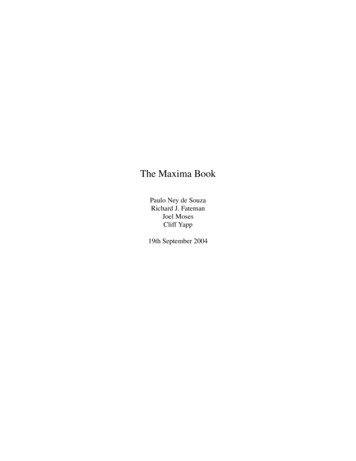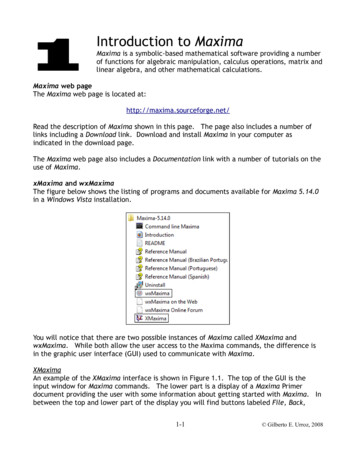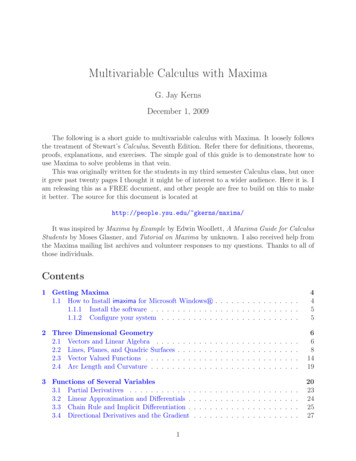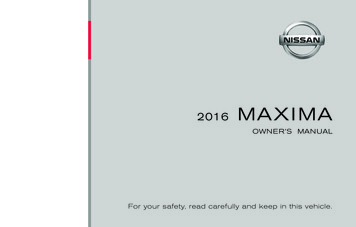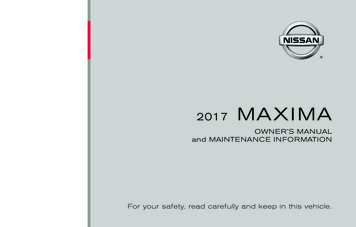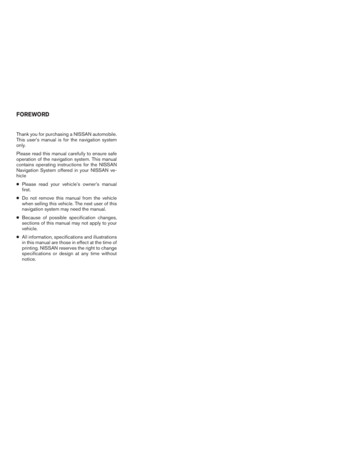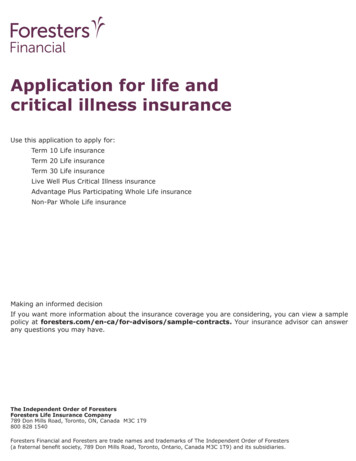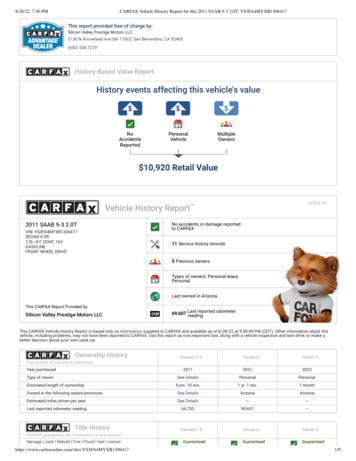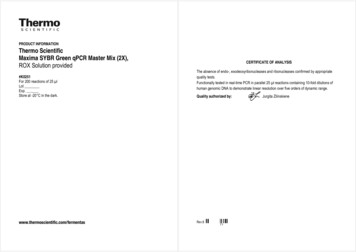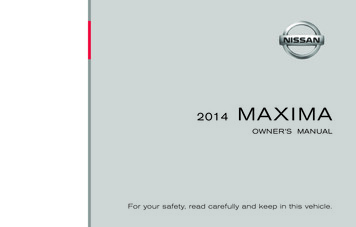
Transcription
2014MA X I MAOWNER’S MANUALFor your safety, read carefully and keep in this vehicle.
FOREWORDWelcome to the growing family of new NISSANowners. This vehicle is delivered to you withconfidence. It was produced using the latesttechniques and strict quality control.This manual was prepared to help you understand the operation and maintenance of yourvehicle so that you may enjoy many miles (kilometers) of driving pleasure. Please read through thismanual before operating your vehicle.READ FIRST—THEN DRIVE SAFELYwarnings, cautions and instructions concerningproper use of such accessories prior to operatingthe vehicle and/or accessory. See a NISSANdealer for details concerning the particular accessories with which your vehicle is equipped.Before driving your vehicle, please read thisOwner’s Manual carefully. This will ensure familiarity with controls and maintenance requirements, assisting you in the safe operation of yourvehicle.WARNINGIMPORTANT SAFETY INFORMATION REMINDERS FOR SAFETY!A separate Warranty Information Bookletexplains details about the warranties covering your vehicle. The “NISSAN Serviceand Maintenance Guide” explains detailsabout maintaining and servicing your vehicle. Additionally, a separate CustomerCare/Lemon Law Booklet (U.S. only) willexplain how to resolve any concerns youmay have with your vehicle, as well asclarify your rights under your state’s lemonlaw.Follow these important driving rules tohelp ensure a safe and comfortable tripfor you and your passengers!Your NISSAN dealership knows your vehiclebest. When you require any service or have anyquestions, they will be glad to assist you with theextensive resources available to them. ALWAYS use your seat belts and appropriate child restraint systems. Preteenchildren should be seated in the rear seat.In addition to factory installed options, your vehicle may also be equipped with additional accessories installed by NISSAN or by yourNISSAN dealer prior to delivery. It is importantthat you familiarize yourself with all disclosures, NEVER drive under the influence of alcohol or drugs. ALWAYS observe posted speed limitsand never drive too fast for conditions. ALWAYS give your full attention to drivingand avoid using vehicle features or takingother actions that could distract you. ALWAYS provide information about theproper use of vehicle safety features toall occupants of the vehicle. ALWAYS review this Owner’s Manualfor important safety information.
WHEN READING THE MANUALMODIFICATION OF YOUR VEHICLEThis vehicle should not be modified.Modificationcouldaffectitsperformance, safety or durability, andmayevenviolategovernmentalregulations. In addition, damage or performance problems resulting from modifications may not be covered underNISSAN warranties.This manual includes information for all featuresand equipment available on this model. Featuresand equipment in your vehicle may vary depending on model, trim level, options selected, order,date of production, region or availability. Therefore, you may find information about features orequipment that are not included or installed onyour vehicle.All information, specifications and illustrations inthis manual are those in effect at the time of printing. NISSAN reserves the right to change specifications, performance, design or component suppliers without notice and without obligation. Fromtime to time, NISSAN may update or revise thismanual to provide Owners with the most accurateinformation currently available. Please carefullyread and retain with this manual all revision updates sent to you by NISSAN to ensure you haveaccess to accurate and up-to-date information regarding your vehicle. Current versions of vehicleOwner’s Manuals and any updates can also befound in the Owner section of the NISSAN gation/manualsGuide. If you have questionsconcerning any information in your Owner’sManual, contact NISSAN Consumer Affairs. Seethe NISSAN CUSTOMER CARE PROGRAMpage in this Owner’s Manual for contact information.IMPORTANT INFORMATION ABOUTTHIS MANUALYou will see various symbols in this manual. Theyare used in the following ways:WARNINGThis is used to indicate the presence of ahazard that could cause death or seriouspersonal injury. To avoid or reduce therisk, the procedures must be followedprecisely.CAUTIONThis is used to indicate the presence of ahazard that could cause minor or moderate personal injury or damage to your vehicle. To avoid or reduce the risk, the procedures must be followed carefully.
CALIFORNIA PROPOSITION 65WARNINGWARNINGAPD1005Engine exhaust, some of its constituents,and certain vehicle components contain oremit chemicals known to the State of California to cause cancer and birth defects orother reproductive harm. In addition, certain fluids contained in vehicles and certain products of component wear containor emit chemicals known to the State ofCalifornia to cause cancer and birth defects or other reproductive harm.If you see this symbol, it means “Do not do this”or “Do not let this happen.”CALIFORNIA PERCHLORATEADVISORYIf you see a symbol similar to these in an illustration, it means the arrow points to the front of thevehicle.Some vehicle parts, such as lithium batteries, may contain perchlorate material. Thefollowing advisory is provided: “PerchlorateMaterial – special handling may apply, BLUETOOTH is atrademark owned byBluetooth SIG, Inc.and licensed toVisteon and Clarion.SiriusXM SatelliteRadio requiressubscription, soldseparately. Notavailable in Alaska,Hawaii or Guam.For moreinformation, visitwww.siriusxm.com. 2013 NISSAN NORTH AMERICA, INC.Arrows in an illustration that are similar to theseindicate movement or action.Arrows in an illustration that are similar to thesecall attention to an item in the illustration.All rights reserved. No part of this Owner’sManual may be reproduced or stored in a retrievalsystem, or transmitted in any form, or by anymeans, electronic, mechanical, photocopying,recording or otherwise, without the prior writtenpermission of Nissan North America, Inc.
NISSAN CUSTOMER CARE PROGRAMNISSAN CARES . . .Both NISSAN and your NISSAN dealer are dedicated to serving all your automotive needs. Your satisfaction with your vehicle and your NISSAN dealer areour primary concerns. Your NISSAN dealer is always available to assist you with all your automobile sales and service needs.However, if there is something that your NISSANdealer cannot assist you with or you would like toprovide NISSAN directly with comments orquestions, please contact the NISSAN Consumer Affairs Department using our toll-freenumber:For U.S. customers1-800-NISSAN-1(1-800-647-7261)For Canadian customers1-800-387-0122The Consumer Affairs Department will ask for thefollowing information:– Your name, address, and telephone number– Vehicle identification number (attached to thetop of the instrument panel on the driver’sside)– Date of purchase– Current odometer reading– Your NISSAN dealer’s name– Your comments or questionsORYou can write to NISSAN with the information at:For U.S. customersNissan North America, Inc.Consumer Affairs DepartmentP.O. Box 685003Franklin, TN 37068-5003or via e-mail at:nnaconsumeraffairs@nissan-usa.comFor Canadian customersNissan Canada Inc.5290 Orbitor DriveMississauga, Ontario L4W 4Z5or via e-mail at:information.centre@nissancanada.comIf you prefer, visit us at:www.nissanusa.com (for U.S. customers) orwww.nissan.ca (for Canadian customers)We appreciate your interest in NISSAN and thank you for buying a quality NISSAN vehicle.
Table ofContentsIllustrated table of contents0Safety—Seats, seat belts and supplemental restraint system1Instruments and controls2Pre-driving checks and adjustments3Monitor, climate, audio, phone and voice recognition systems4Starting and driving5In case of emergency6Appearance and care7Maintenance and do-it-yourself8Technical and consumer information9Index10
0 Illustrated table of contentsAir bags, seat belts and child restraints . . . . . . . . . . . . . . 0-2Exterior front . . . . . . . . . . . . . . . . . . . . . . . . . . . . . . . . . . . . . . 0-3Exterior rear. . . . . . . . . . . . . . . . . . . . . . . . . . . . . . . . . . . . . . . 0-4Passenger compartment . . . . . . . . . . . . . . . . . . . . . . . . . . . 0-5Instrument panel. . . . . . . . . . . . . . . . . . . . . . . . . . . . . . . . . . . 0-6Engine compartment check locations . . . . . . . . . . . . . . . . 0-8Warning/indicator lights . . . . . . . . . . . . . . . . . . . . . . . . . . . . 0-9
AIR BAGS, SEAT BELTS AND CHILDRESTRAINTS1.2.3.4.Top tether strap anchor (P. 1-38)Rear head restraints/headrests (P. 1-7)Rear seat belts (P. 1-15)Roof-mounted curtain side-impactsupplemental air bag (P. 1-42)5. Front seat-mounted side-impactsupplemental air bags (P. 1-42)6. Front head restraints/headrests (P. 1-7)7. Front seat belts (P. 1-15)8. Supplemental front-impact air bags(P. 1-42)9. Seats (P. 1-2)10. Occupant classification sensor(pattern sensor) (P.1-49)11. Seat belts with pretensioners (P. 1-55)12. LATCH (Lower Anchors and Tethers forCHildren) system (P. 1-26)See the page number indicated in parentheses for operating details.LII00650-2 Illustrated table of contents
EXTERIOR FRONT1.2.3.4.5.6.7.8.9.10.11.12.13.Engine hood (P. 3-17)Windshield wiper and washer switch(P. 2-28)Windshield (P. 8-20)Moonroof (if so equipped) (P. 2-46)Power windows (P. 2-43)Door locks, NISSAN Intelligent Key ,keys, request button (P. 3-4, 3-2, 3-2,3-2)Mirrors (P. 3-25)Tire pressure (P. 8-32)Flat tire (P. 6-3)Tire chains (P. 8-40)Headlight and turn signal switch(P. 2-30)Replacing bulbs (P. 8-30)Fog light switch (if so equipped)(P. 8-27)See the page number indicated in parentheses for operating details.WII0155Illustrated table of contents 0-3
EXTERIOR REAR1.2.3.4.5.6.7.8.9.Rear window defroster switch (P. 2-29)Interior trunk lid release (P. 3-19)Trunk lid (P. 3-17)Vehicle loading (P. 9-12)Exterior trunk lid release/request button(P. 3-12)Replacing bulbs (P. 8-30)Fuel-filler cap, fuel recommendation(P. 3-20, P. 9-28 )Fuel-filler door (P. 3-20)Child safety rear door locks (P. 3-6)See the page number indicated in parentheses for operating details.WII01560-4 Illustrated table of contents
PASSENGER COMPARTMENT1.2.3.4.5.Interior trunk access (P. 1-5)Moonroof (if so equipped) (P. 2-46)Sun visors (P. 3-24)Interior lights, illuminated entry (P. 2-50)HomeLink universal transceiver(if so equipped) (P. 2-53)6. Interior mirrors (P. 3-25)7. Glove box (P. 2-41)8. Cup holders (P. 2-40)9. Console box (P. 2-41)10. Front seat (P. 1-2)11. Rear seat (P. 1-5)See the page number indicated in parentheses for operating details.WII0126Illustrated table of contents 0-5
INSTRUMENT 3.Side and center vents (P. 4-28)Headlight/fog light (if so equipped)/turnsignal switch (P. 2-30)Steering wheel switch for audio controland Bluetooth Hands-Free PhoneSystem (P. 4-89, 4-92)0-6 Illustrated table of contents4.5.6.7.Meters and gauges (P. 2-3)Driver supplemental air bag/horn(P. 1-42, P. 2-34)Security indicator light (P. 2-26)Cruise control main/set switches(P. 5-19)20.21.22.23.Shift paddles (if so equipped) (P. 5-15)Windshield wiper/washer switch(P. 2-28)Display screen/Navigation system*(if so equipped) (P. 4-11)Display screen/Navigation system*controls (if so equipped) (P. 4-11)Front passenger supplemental air bag(P. 1-56)Glove box (P. 2-41)Display screen (models without Navigation system) (P. 4-4)Climate controls (models without Navigation system) (P. 4-29)Audio system controls (models withoutNavigation system) (P. 4-35)Front passenger air bag status light(P. 1-49)Audio system controls (P. 4-35)Climate controls (models with Navigation system) (P. 4-32)Shift lever (P. 5-12)Hazard warning flasher switch (P. 6-2)Ignition switch (behind the steeringwheel) (P. 5-7)Tilt/telescopic steering wheel controls(if so equipped) (P. 3-22)
24.Vehicle Dynamic Control (VDC) OFFswitch (P. 2-37)Outside mirror controls (P. 3-27)Heated steering wheel switch (if soequipped) (P. 2-37)Trunk lid release switch (P. 3-19)* Refer to the separate Navigation System Owner’s Manual (if so equipped).See the page number indicated in parentheses for operating details.Illustrated table of contents 0-7
ENGINE COMPARTMENT CHECKLOCATIONS1.2.3.4.5.6.7.8.9.10.11.12.Power steering fluid reservoir (P. 8-13)Engine oil filler cap (P. 8-10)Brake fluid reservoir (P. 8-14)Air cleaner (P. 8-19)Fuse block (P. 8-22)Battery (P. 8-15)Fuse/fusible link box (P. 8-22)Engine oil dipstick (P. 8-10)Radiator cap (P. 8-8)Drive belt location (P.8-17)Engine coolant reservoir * (P. 8-8)Windshield-washer fluid reservoir *(P. 8-14)NOTE:* Side covers removed for clarity.See the page number indicated in parentheses for operating details.WDI06620-8 Illustrated table of contents
WARNING/INDICATOR LIGHTSWarninglightorNamePageAnti-lock BrakingSystem (ABS) warning light2-11Brake warning ageSeat belt warninglight and chime2-14High beam indicatorlight (blue)2-15Supplemental airbag warning light2-14Malfunction Indicator Light (MIL)2-15NamePageSecurity indicatorlight2-16Continuously Variable Transmission(CVT) indicator light2-14Side light and headlight indicator light(green)2-16Continuously Variable Transmission(CVT) position indicator light2-10Slip indicator light2-16Turn signal/hazardindicator lights2-16Vehicle DynamicControl OFF indicator light2-16Charge warninglight2-11Engine oil pressurewarning light2-12Low tire pressurewarning light2-12Cruise main switchindicator light2-152-14Front passenger airbag status light2-15Master warning lightIndicatorlightIllustrated table of contents 0-9
MEMO0-10 Illustrated table of contents
1 Safety—Seats, seat belts andsupplemental restraint systemSeats . . . . . . . . . . . . . . . . . . . . . . . . . . . . . . . . . . . . . . . . . . . . 1-2Front power seat adjustment. . . . . . . . . . . . . . . . . . . . . 1-3Folding rear seat (if so equipped). . . . . . . . . . . . . . . . . 1-5Front seat head restraints/headrests . . . . . . . . . . . . . . 1-7Rear seat head restraints/headrests . . . . . . . . . . . . . 1-11Seat belts . . . . . . . . . . . . . . . . . . . . . . . . . . . . . . . . . . . . . . . 1-15Precautions on seat belt usage. . . . . . . . . . . . . . . . . . 1-15Pregnant women . . . . . . . . . . . . . . . . . . . . . . . . . . . . . . 1-18Injured persons. . . . . . . . . . . . . . . . . . . . . . . . . . . . . . . . 1-18Three-point type seat belt with retractor . . . . . . . . . . 1-18Seat belt extenders . . . . . . . . . . . . . . . . . . . . . . . . . . . . 1-21Seat belt maintenance . . . . . . . . . . . . . . . . . . . . . . . . . 1-22Child safety . . . . . . . . . . . . . . . . . . . . . . . . . . . . . . . . . . . . . . 1-22Infants. . . . . . . . . . . . . . . . . . . . . . . . . . . . . . . . . . . . . . . . 1-23Small children . . . . . . . . . . . . . . . . . . . . . . . . . . . . . . . . . 1-23Larger children . . . . . . . . . . . . . . . . . . . . . . . . . . . . . . . . 1-23Child restraints . . . . . . . . . . . . . . . . . . . . . . . . . . . . . . . . . . . 1-24Precautions on child restraints . . . . . . . . . . . . . . . . . . 1-24LATCH (Lower Anchors and Tethers forCHildren) System . . . . . . . . . . . . . . . . . . . . . . . . . . . . . 1-26Rear-facing child restraint installation usingLATCH . . . . . . . . . . . . . . . . . . . . . . . . . . . . . . . . . . . . . . . 1-28Rear-facing child restraint installation usingthe seat belts . . . . . . . . . . . . . . . . . . . . . . . . . . . . . . . . . 1-30Forward-facing child restraint installationusing LATCH. . . . . . . . . . . . . . . . . . . . . . . . . . . . . . . . . . 1-33Forward-facing child restraint installationusing the seat belts . . . . . . . . . . . . . . . . . . . . . . . . . . . . 1-35Installing top tether strap . . . . . . . . . . . . . . . . . . . . . . . 1-38Booster seats . . . . . . . . . . . . . . . . . . . . . . . . . . . . . . . . . 1-39Supplemental restraint system . . . . . . . . . . . . . . . . . . . . . 1-42Precautions on supplemental restraintsystem . . . . . . . . . . . . . . . . . . . . . . . . . . . . . . . . . . . . . . . 1-42Supplemental air bag warning labels . . . . . . . . . . . . . 1-56Supplemental air bag warning light . . . . . . . . . . . . . . 1-56
SEATS Do not adjust the driver’s seat whiledriving so full attention may be given tovehicle operation. The seat may movesuddenly and could cause loss of control of the vehicle. The seatback should not be reclinedany more than needed for comfort. Seatbelts are most effective when the passenger sits well back and straight up inthe seat. If the seatback is reclined, therisk of sliding under the lap belt andbeing injured is increased.ARS1152WARNING Do not ride in a moving vehicle whenthe seatback is reclined. This can bedangerous. The shoulder belt will notbe against your body. In an accident,you could be thrown into it and receiveneck or other serious injuries. Youcould also slide under the lap belt andreceive serious internal injuries. For the most effective protection whenthe vehicle is in motion, the seat shouldbe upright. Always sit well back in theseat with both feet on the floor andadjust the seat properly. See “Precautions on seat belt usage” later in thissection. After adjustment, gently rock in the seatto make sure it is securely locked. Do not leave children unattended insidethe vehicle. They could unknowingly activate switches or controls. Unattendedchildren could become involved in serious accidents.1-2 Safety—Seats, seat belts and supplemental restraint systemCAUTIONWhen adjusting the seat positions, besure not to contact any moving parts toavoid possible injuries and/or damage.
The reclining feature allows adjustment of theseatback for occupants of different sizes foradded comfort and to help obtain proper seatbelt fit. See “Precautions on seat belt usage” laterin this section. Also, the seatback can be reclinedto allow occupants to rest when the vehicle isstopped and the shift lever is in P (Park).LRS2190FRONT POWER SEAT ADJUSTMENTForward and backwardOperating tipsMoving the switch forward or backward will slidethe seat forward or backward to the desiredposition. The power seat motor has an auto-resetoverload protection circuit. If the motorstops during operation, wait 30 seconds,then reactivate the switch. Do not operate the power seat switch for along period of time when the engine is off.This will discharge the battery.RecliningMove the recline switch backward until the desired angle is obtained. To bring the seatbackforward again, move the switch forward andmove your body forward. The seatback will moveforward.See “Automatic drive positioner” in “Pre-drivingchecks and adjustments” for automatic drive positioner operation.Safety—Seats, seat belts and supplemental restraint system 1-3
LRS0862LRS2191Seat lifter (driver’s seat)Push the front or rear end of the switch up ordown to adjust the angle and height of the seatcushion.Manual (if so equipped)Lumbar support (driver’s seat)The lumbar support feature provides adjustablelower back support to the driver. Move the leverup or down (manual) or move the switch forwardor backward (power) to adjust the seat lumbararea.1-4 Safety—Seats, seat belts and supplemental restraint systemLRS2192Power (if so equipped)
Interior trunk accessFor models without a rear center console, thetrunk can be accessed from the passenger sideof the rear seat for loading and unloading, asshown.1䊊2䊊Press down on the button on the rear parcelshelf.Fold down the passenger side seatback.WARNING Never allow anyone to ride in the cargoarea or on the rear seat when it is in thefold-down position. Use of these areasby passengers without proper restraintscould result in serious injury in an accident or sudden stop.LRS0863Thigh extension (driver’s side only, ifso equipped)Pull up and hold the lever to extend the frontportion to the desired position.WRS0866FOLDING REAR SEAT (if soequipped) Properly secure all cargo with ropes orstraps to help prevent it from sliding orshifting. Do not place cargo higher thanthe seatbacks. In a sudden stop or collision, unsecured cargo could causepersonal injury.Safety—Seats, seat belts and supplemental restraint system 1-5
When returning the seatbacks to theupright position, be certain they arecompletely secured in the latched position. If they are not completely secured,passengers may be injured in an accident or sudden stop. Closely supervise children when theyare around cars to prevent them fromplaying and becoming locked in thetrunk where they could be seriously injured. Keep the car locked, with the rearseatback and trunk lid securely latchedwhen not in use, and prevent children’saccess to car keys.WRS0867LPD0459To fold down the driver side of the rear seat, reach1through the opening and pull on the strap 䊊located behind the seat.Secondary trunk lid release (if soequipped)The rear seats can be locked using the mechanical key to prevent unauthorized access.For models with a rear center console, the trunkcan be accessed through the access panel between the rear seats, as shown. Fold down the center arm rest. Insert the mechanical key into the trunk compartment access lid lock. Fold down thetrunk compartment access lid. For more information on the mechanical key, see“NISSAN Intelligent Key ” in the Predriving checks and adjustments chapter.1 . Pull the rear seat trunk release handle 䊊1-6 Safety—Seats, seat belts and supplemental restraint system
FRONT SEAT HEAD RESTRAINTS/HEADRESTSWARNINGWRS0868Center armrestPull the armrest down until it rests on the seatcushion. Head restraints/headrests supplementthe other vehicle safety systems. Theymay provide additional protectionagainst injury in certain rear end collisions.Adjusttheheadrestraints/headrests properly, as specified in this section. Check the adjustment after someone else uses the seat.Do not attach anything to the headrestraint/headrest stalks or remove thehead restraints/headrests. Do not usethe seat if the head restraint/headresthas been removed. If the headrestraint/headrest was removed, reinstall and properly adjust the headrestraint/headrest before an occupantuses the seating position. Failure to follow these instructions can reduce theeffectivenessoftheheadrestraints/headrests. This may increasethe risk of serious injury or death in acollision.LRS2000The illustration shows the seating positionsequipped with head restraints/headrests. Thehead restraints in the front seats are adjustableand removable.䉱 Indicates the seating position is equipped witha head restraint.䡲 Indicates the seating position is equipped witha headrest. Indicates the seating position is not equippedwith a head restraint or headrest. Your vehicle is equipped with a headrestraint/headrest that may be integrated,adjustable or non-adjustable.Safety—Seats, seat belts and supplemental restraint system 1-7
Adjustable head restraints/headrests havemultiple notches along the stalk to lock themin a desired adjustment position. Thenon-adjustableheadrestraints/headrests have a single lockingnotch to secure them to the seat frame. Proper Adjustment:– For the adjustable type, align the headrestraint/headrest so the center of yourear is approximately level with the centerof the head restraint/headrest.– If your ear position is still higher than therecommended alignment, place the headrestraint/headrest at the highest position. If the head restraint/headrest has been removed, ensure that it is reinstalled andlocked in place before riding in that designated seating position.LRS2300Adjustable head restraint/headrestcomponentsLRS2299Non-adjustable head restraint/headrest components1. Removable head restraint/headrest1. Removable head restraint/headrest2. Multiple notches2. Single Notch3. Lock knob3. Lock knob4. Stalks4. Stalks1-8 Safety—Seats, seat belts and supplemental restraint system
LRS2302RemovableUse the following procedure to remove the headrestraints/headrests.1. Pull the head restraint/headrest up to thehighest position.2. Push and hold the lock knob.LRS2303Install1. Align the head restraint/headrest stalks withthe holes in the seat. Make sure the headrestraint/headrest is facing the correct direction. The stalk with the notch (notches)1 must be installed in the hole with the lock䊊2 .knob 䊊3. Remove the head restraint/headrest fromthe seat.2. Push and hold the lock knob and the headrestraint/headrest down.4. Store the head restraint/headrest properly in asecure place so it is not loose in the vehicle.3. Properly adjust the head restraint/headrestbefore an occupant uses the seating position.5. Reinstall and properly adjust the headrestraint/headrest before an occupant usesthe seating position.WRS0134For adjustable head restraint/headrestAdjust the head restraint/headrest so the centeris level with the center of your ears. If your earposition is still higher than the recommendedalignment, place the head restraint/headrest atthe highest position.Safety—Seats, seat belts and supplemental restraint system 1-9
LRS2351LRS2305For non-adjustable head restraint/headrestTo raise the head restraint/headrest,pull it up.Make sure the head restraint/headrest is positioned so the lock knob is engaged in the notchbefore riding in that designated seating position.Make sure the head restraint/headrest is positioned so the lock knob is engaged in the notchbefore riding in that designated seating position.1-10 Safety—Seats, seat belts and supplemental restraint systemLRS2306To lower, push and hold the lock knoband push the head restraint/headrestdown.Make sure the head restraint/headrest is positioned so the lock knob is engaged in the notchbefore riding in that designated seating position.
Your vehicle is equipped with a headrestraint/headrest that may be integrated,adjustable or non-adjustable.REAR SEAT HEAD RESTRAINTS/HEADRESTS Adjustable head restraints/headrests havemultiple notches along the stalk to lock themin a desired adjustment position.WARNING Head restraints/headrests supplementthe other vehicle safety systems. Theymay provide additional protectionagainst injury in certain rear end collisions.Adjusttheheadrestraints/headrests properly, as specified in this section. Check the adjustment after someone else uses the seat.Do not attach anything to the headrestraint/headrest stalks or remove thehead restraint/headrest. Do not use theseat if the head restraint/headrest hasbeenremoved.Iftheheadrestraint/headrest was removed, reinstall and properly adjust the headrestraint/headrest before an occupantuses the seating position. Failure to follow these instructions can reduce theeffectivenessoftheheadrestraints/headrests. This may increasethe risk of serious injury or death in acollision. The non-adjustable head restraints/headrestshave a single locking notch to secure them tothe seat frame. Proper Adjustment:LRS2000The illustration shows the seating positionsequipped with head restraints/headrests. Therear outboard seating positions are adjustableand removable. The center rear position headrestdoes not adjust and is not removable.䉱 Indicates the seating position is equipped witha head restraint.䡲 Indicates the seating position is equipped witha headrest.– For the adjustable type, align the headrestraint/headrest so the center of yourear is approximately level with the centerof the head restraint/headrest.– If your ear position is still higher than therecommended alignment, place the headrestraint/headrest at the highest position. If the head restraint/headrest has been removed, ensure that it is reinstalled andlocked in place before riding in that designated seating position. Indicates the seating position is not equippedwith a head restraint or headrest.Safety—Seats, seat belts and supplemental restraint system 1-11
LRS2310Adjustable head restraint/headrestcomponentsLRS2315Non-adjustable head restraint/headrest componentsLRS2074RemovalUse the following procedure to remove the headrestraints/headrests.1. Removable head restraint/headrest1. Removable head restraint/headrest2. Multiple notches2. Single Notch1. Adjust the seat or seatback as necessary.3. Lock knobs3. Lock knobs2. Push and hold the lock knobs.4. Stalks4. Stalks3. Pull the head restraint/headrest up until it isremoved from the seat.4. Store the head restraint/headrest properlyso it is not loose in the vehicle.5. Reinstall the head restraint/headrest andproperly adjust the seat or seatback beforean occupant uses the seating position.1-12 Safety—Seats, seat belts and supplemental restraint system
LRS2075Install1. Align the head restraint/headrest stalks withthe holes in the seat. Make sure the headrestraint/headrest is facing the correct direction.2. Push the head restraint/headrest down untilit locks in place.WRS0134For adjustable head restraint/headrestAdjust the head restraint/headrest so the centeris level with the center of your ears. If your earposition is still higher than the recommendedalignment, place the head restraint/headrest atthe highest position.LRS2351For non-adjustable head restraint/headrestMake sure the head restraint/headrest is positioned so the lock knob is engaged in the notchbefore riding in that designated seating position.Safety—Seats, seat belts and supplemental restraint system 1-13
LRS2305To raise the head restraint/headrest,pull it up.Make sure the head restraint/headrest is positioned so the lock knob is engaged in the notchbefore riding in that designated seating position.LRS2306To lower, push and hold the lock knoband push the head restraint/headrestdown.Make sure the head restraint/headrest is positioned so the lock knob is engaged in the notchbefore riding in that designated seating position.SPA1025Front-seat Act
2014 MAXIMA OWNER'S MANUAL For your safety, read carefully and keep in this vehicle. 2014 NISSAN MAXIMA A35-D Printing : July 2013 (13) Publication No.: Printed in U.S.A. A35-D OM14E 0A35U0. Welcome to the growing family of new NISSAN owners. This vehicle is delivered to you with
